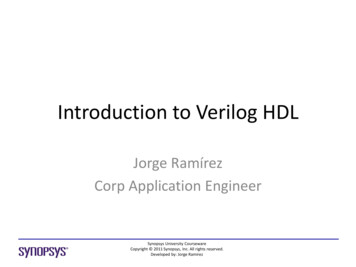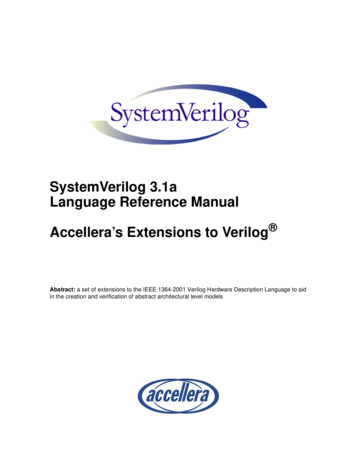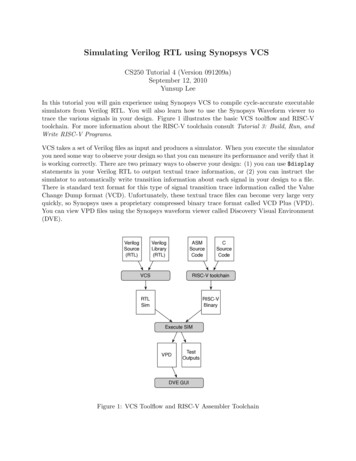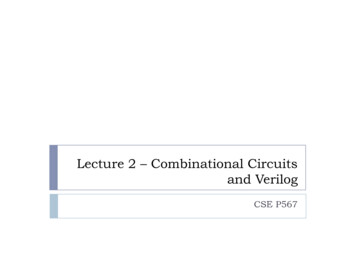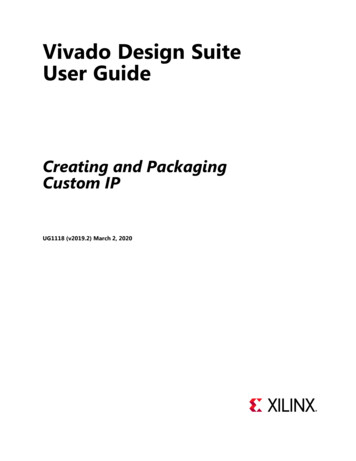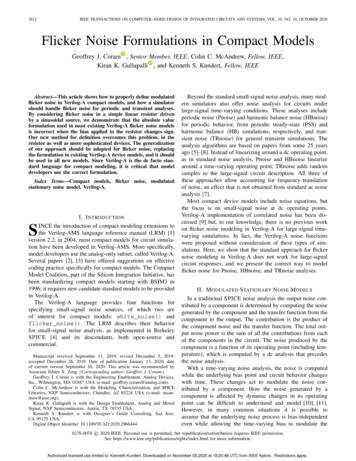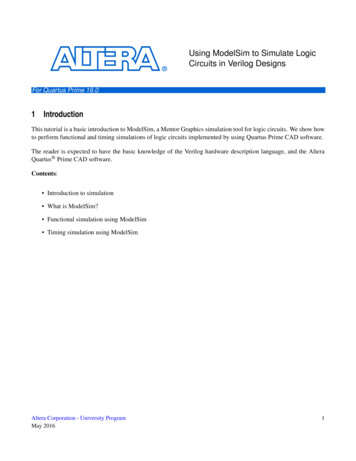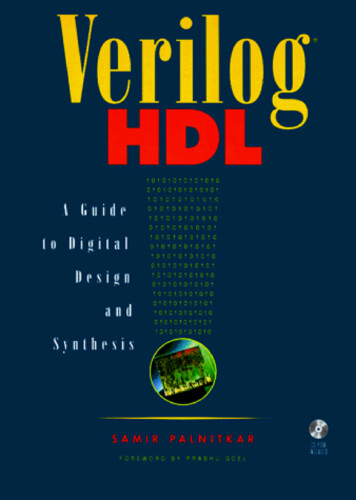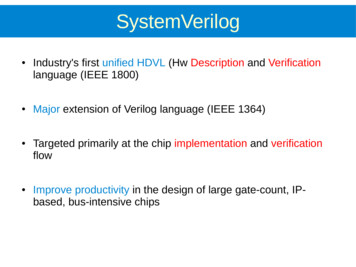
Transcription
verilog#verilog
Table of ContentsAbout1Chapter 1: Getting started with verilog2Remarks2Versions2Examples2Installation or Setup2Introduction2Hello World5Installation of Icarus Verilog Compiler for Mac OSX Sierra6Install GTKWave for graphical display of simulation data on Mac OSx Sierra7Using Icarus Verilog and GTKWaves to simulate and view a design graphically7Chapter 2: Hello WorldExamples1212Compiling and Running the Example12Hello World12Chapter 3: Memories14Remarks14Examples14Simple Dual Port RAM14Single Port Synchronous RAM14Shift register15Single Port Async Read/Write RAM15Chapter 4: Procedural Blocks17Syntax17Examples17Simple counter17Non-blocking assignments17Chapter 5: Synthesis vs Simulation mismatch19Introduction19Examples19
Comparison19Sensitivity list19Credits20
AboutYou can share this PDF with anyone you feel could benefit from it, downloaded the latest versionfrom: verilogIt is an unofficial and free verilog ebook created for educational purposes. All the content isextracted from Stack Overflow Documentation, which is written by many hardworking individuals atStack Overflow. It is neither affiliated with Stack Overflow nor official verilog.The content is released under Creative Commons BY-SA, and the list of contributors to eachchapter are provided in the credits section at the end of this book. Images may be copyright oftheir respective owners unless otherwise specified. All trademarks and registered trademarks arethe property of their respective company owners.Use the content presented in this book at your own risk; it is not guaranteed to be correct noraccurate, please send your feedback and corrections to info@zzzprojects.comhttps://riptutorial.com/1
Chapter 1: Getting started with verilogRemarksVerilog is a hardware description language (HDL) that is used to design, simulate, and verifydigital circuitry at a behavioral or register-transfer level. It is noteworthy for a reasons thatdistinguish it from "traditional" programming languages: There are two types of assignment, blocking and non-blocking, each with their own uses andsemantics. Variables must be declared as either single-bit wide or with an explicit width. Designs are hierarchical, with the ability to instantiate modules that have a desiredbehaviour. In simulation (not typically in synthesis), wire variables may be in one of four states: 0, 1,floating (z), and undefined (x).VersionsVersionRelease DateVerilog IEEE-1364-19951995-01-01Verilog IEEE-1364-20012001-09-28Verilog IEEE-1364.1-20022002-12-18Verilog IEEE-1364-20052006-04-07SystemVerilog IEEE-1800-20092009-12-11SystemVerilog IEEE-1800-20122013-02-21ExamplesInstallation or SetupDetailed instructions on getting Verilog set up or installed is dependent on the tool you use sincethere are many Verilog tools.IntroductionVerilog is a hardware description language (HDL) used to model electronic systems. It mostcommonly describes an electronic system at the register-transfer level (RTL) of abstraction. It isalso used in the verification of analog circuits and mixed-signal circuits. Its structure and mainhttps://riptutorial.com/2
principles ( as described below ) are designed to describe and successfully implement anelectronic system. RigidityAn electronic circuit is a physical entity having a fixed structure and Verilog is adapted forthat. Modules (module), Ports(input/output/inout) , connections (wires), blocks (@always),registers (reg) are all fixed at compile time. The number of entities and interconnects do notchange dynamically. There is always a "module" at the top-level representing the chipstructure (for synthesis), and one at the system level for verification. ParallelismThe inherent simultaneous operations in the physical chip is mimicked in the language byalways (most commmon), initial and fork/join blocks.module top();reg r1,r2,r3,r4; // 1-bit registersinitialbeginr1 0 ;endinitialbeginforkr2 0 ;r3 0 ;joinendalways @(r4)r4 0 ;endmoduleAll of the above statements are executed in parallel within the same time unit. Timing and SynchronizationVerilog supports various constructs to describe the temporal nature of circuits. Timings anddelays in circuits can be implemented in Verilog, for example by #delay constructs. Similarly,Verilog also accommodates for synchronous and asynchronous circuits and components likeflops, latches and combinatorial logic using various constructs, for example "always" blocks.A set of blocks can also be synchronized via a common clock signal or a block can betriggered based on specific set of inputs.#10;always @(posedge clk )always @(sig1 or sig2 )@(posedge event1)wait (signal 1)//////////delay for 10 time unitssynchronouscombinatorial logicwait for post edge transition of event1wait for signal to be 1 UncertaintyVerilog supports some of the uncertainty inherent in electronic circuits. "X" is used torepresent unknown state of the circuit. "Z" is used to represent undriven state of the circuit.reg1 1'bx;https://riptutorial.com/3
reg2 1'bz; AbstractionVerilog supports designing at different levels of abstraction. The highest level of abstractionfor a design is the Resister transfer Level (RTL), the next being the gate level and the lowestthe cell level ( User Define Primitives ), RTL abstraction being the most commonly used.Verilog also supports behavioral level of abstraction with no regard to the structuralrealization of the design, primarily used for verification.// Example of a D flip flop at RTL abstractionmodule dff (clk, // Clock Inputreset , // Reset inputd, // Data Inputq// Q output);//-----------Input Ports--------------input d, clk, reset ;//-----------Output Ports--------------output q;reg q;always @ ( posedge clk)if ( reset) beginq 1'b0;end else beginq d;endendmodule// And gate model based at Gate level abstractionmodule and(input x,input y,output o);wire w;// Two instantiations of the module NANDnand U1(w,x, y);nand U2(o, w, w);endmodule// Gate modeled at Cell-level Abstractionprimitive udp and(a, // declare three portsb,c);output a;// Outputsinput b,c; // Inputs// UDP// A table// B1function code hereB & C;C1: A: 1;https://riptutorial.com/4
0 11 00 0endtable: 0;: 0;: 0;endprimitiveThere are three main use cases for Verilog. They determine the structure of the code and itsinterpretation and also determine the tool sets used. All three applications are necessary forsuccessful implementation of any Verilog design.1. Physical Design / Back-endHere Verilog is used to primarily view the design as a matrix of interconnecting gatesimplementing logical design. RTL/logic/Design goes through various steps from synthesis - placement - clock tree construction - routing - DRC - LVS - to tapeout. The precisesteps and sequences vary based on the exact nature of implementation.2. SimulationIn this use case, the primary aim is to generate test vectors to validate the design as per thespecification. The code written in this use case need not be synthesizable and it remainswithin verification sphere. The code here more closely resembles generic software structureslike for/while/do loops etc.3. DesignDesign involves implementing the specification of a circuit generally at the RTL level ofabstraction. The Verilog code is then given for Verification and the fully verified code is givenfor physical implementation. The code is written using only the synthesizable constructs ofVerilog. Certain RTL coding style can cause simulation vs synthesis mismatch and care hasto be taken to avoid those.There are two main implementation flows. They will also affect the way Verilog code is written andimplemented. Certain styles of coding and certain structures are more suitable in one flow over theother. ASIC Flow (application-specific integrated circuit) FPGA Flow (Field-programmable gate array) - include FPGA and CPLD'sHello WorldThis example uses the icarus verilog compiler.Step 1: Create a file called hello.vmodule myModule();initialbegin display("Hello World!");// This will display a message finish ; // This causes the simulation to end. Without, it would go on.and on.endhttps://riptutorial.com/5
endmoduleStep 2. We compile the .v file using icarus: iverilog -o hello.vvp hello.vThe -o switch assigns a name to the output object file. Without this switch the output file would becalled a.out. The hello.v indicates the source file to be compiled. There should be practically nooutput when you compile this source code, unless there are errors.Step 3. You are ready to simulate this Hello World verilog program. To do so, invoke as such: vvp hello.vvpHello World! Installation of Icarus Verilog Compiler for Mac OSX Sierra1. Install Xcode from the App Store.2. Install the Xcode developer tools xcode-select --installThis will provide basic command line tools such as gcc and make3. Install Mac Ports https://www.macports.org/install.phpThe OSX Sierra install package will provide an open-source method of installing and upgradingadditional software packages on the Mac platform. Think yum or apt-get for the Mac.4. Install icarus using Mac ports sudo port install iverilog5. Verify the installation from the command line iverilogiverilog: no source files.Usage: iverilog [-ESvV] [-B base] [-c cmdfile -f cmdfile][-g1995 -g2001 -g2005] [-g feature ][-D macro[ defn]] [-I includedir] [-M depfile] [-m module][-N file] [-o filename] [-p flag value][-s topmodule] [-t target] [-T min typ max][-W class] [-y dir] [-Y suf] source file(s)See the man page for details. You are now ready to compile and simulate your first Verilog file on the Mac.https://riptutorial.com/6
Install GTKWave for graphical display of simulation data on Mac OSx SierraGTKWave is a fully feature graphical viewing package that supports several graphical datastorage standards, but it also happens to support VCD, which is the format that vvp will output. So,to pick up GTKWave, you have a couple options1. Goto http://gtkwave.sourceforge.net/gtkwave.zip and download it. This version is typically thelatest.2. If you have installed MacPorts (https://www.macports.org/), simply run sudo port installgtkwave. This will probably want to install on the dependencies to. Note this method willusually get you an older version. If you don't have MacPorts installed, there is a installationsetup example for doing this on this page. Yes! You will need all of the xcode developertools, as this methods will "build" you a GTKWave from source.When installation is done, you may be asked to select a python version. I already had 2.7.10installed so I never "selected" a new one.At this point you can start gtkwave from the command line with gtkwave. When it starts you may beasked to install, or update XQuarts. Do so. In my case XQuarts 2.7.11 is installed.Note: I actually needed to reboot to get XQuarts correctly, then I typed gtkwave again and theapplication comes up.In the next example, I will create two independent files, a testbench and module to test, and wewill use the gtkwave to view the design.Using Icarus Verilog and GTKWaves to simulate and view a design graphicallyThis example uses Icarus and GTKWave. Installation instructions for those tools on OSx areprovided elsewhere on this page.Lets begin with the module design. This module is a BCD to 7 segment display. I have coded thedesign in an obtuse way simply to give us something that is easily broken and we can spendsometime fixing graphically. So we have a clock, reset, a 4 data input representing a BCD value,and a 7 bit output that represent the seven segment display. Create a file called bcd to 7seg.vand place the source below in it.module bcd to 7seg (input clk,input reset,input [3:0] bcd,output [6:0] seven seg display);parameter TP 1;reg seg a;reg seg b;reg seg c;reg seg d;reg seg e;reg seg f;https://riptutorial.com/7
reg seg g;always @ (posedgebeginif (reset)beginseg a seg b seg c seg d seg e seg f seg g endelsebeginseg a seg b seg c seg d seg e seg f seg g endendclk or posedge b0;1'b0;1'b0;1'b0;1'b0;1'b0;1'b0; (bcd 4'h1 bcd 4'h4);bcd 4'h5 bcd 6;bcd ! 2;bcd 0 bcd[3:1] 3'b001 bcd 5 bcd 6 bcd 8;bcd 0 bcd 2 bcd 6 bcd 8;bcd 0 bcd 4 bcd 5 bcd 6 bcd 7;(bcd 1 && bcd 7) (bcd 7);assign seven seg display {seg g,seg f,seg e,seg d,seg c,seg b,seg a};endmoduleNext, we need a test to check if this module is working correctly. The case statement in thetestbench is actually easier to read in my opinion and more clear as to what it does. But I did notwan to put the same case statment in the design AND in the test. That is bad practice. Rather twoindependent designs are being used to validate one-another.Withing the code below, you will notice two lines dumpfile("testbench.vcd"); and dumpvars(0,testbench);. These lines are what create the VCD output file that will be used toperform graphical analysis of the design. If you leave them out, you won't get a VCD filegenerated. Create a file called testbench.v and place the source below in it. timescale 1ns/100psmodule testbench;reg clk;reg reset;reg [31:0] ii;reg [31:0] error count;reg [3:0] bcd;wire [6:0] seven seg display;parameter TP 1;parameter CLK HALF PERIOD 5;// assign clk #CLK HALF PERIOD clk; // Create a clock with a period of ten nsinitialbeginclk 0;#5;forever clk #( CLK HALF PERIOD ) clk;endhttps://riptutorial.com/8
initialbegin dumpfile("testbench.vcd"); dumpvars(0,testbench);// clk #CLK HALF PERIOD clk; display("%0t, Reseting system", time);error count 0;bcd 4'h0;reset #TP 1'b1;repeat (30) @ (posedge clk);reset #TP 1'b0;repeat (30) @ (posedge clk); display("%0t, Begin BCD test", time); // This displays a messagefor (ii 0; ii 10; ii ii 1)beginrepeat (1) @ (posedge clk);bcd ii[3:0];repeat (1) @ (posedge clk);if (seven seg display ! seven seg prediction(bcd))begin display("%0t, ERROR: For BCD %d, module output 0b%07b does not matchprediction logic value of 0b%07b.", time,bcd, seven seg display,seven seg prediction(bcd));error count error count 1;endend display("%0t, Test Complete with %d errors", time, error count); display("%0t, Test %s", time, error count ? "pass." : "fail."); finish ; // This causes the simulation to erparameterparameterSEG ASEG BSEG CSEG DSEG ESEG FSEG G 0000;7'b0100000;7'b1000000;function [6:0] seven seg prediction;input [3:0] bcd in;////////////////// --- A --- FB --- G --- EC --- D --- begincase (bcd in)4'h0: seven seg prediction4'h1: seven seg prediction4'h2: seven seg prediction4'h3: seven seg predictionhttps://riptutorial.com/ SEG ASEG BSEG ASEG A SEG B SEG C SEG D SEG E SEG F;SEG C;SEG B SEG G SEG E SEG D;SEG B SEG G SEG C SEG D;9
4'h4: seven seg prediction SEG F SEG G4'h5: seven seg prediction SEG A SEG F4'h6: seven seg prediction SEG A SEG F4'h7: seven seg prediction SEG A SEG B4'h8: seven seg prediction SEG A SEG B4'h9: seven seg prediction SEG A SEG Fdefault: seven seg prediction 7'h0;endcase SEG B SEG G SEG G SEG C;SEG C SEG G SEG C;SEG C SEG D;SEG E SEG C SEG D;SEG D SEG E SEG F SEG G;SEG B SEG C;endendfunctionbcd to 7seg u0 bcd to 7seg (.clk(clk),.reset(reset),.bcd(bcd),.seven seg display (seven seg display));endmoduleNow that we have two files, a testbench.v and bcd to 7seg.v, we need to compile, elaborateusing Icarus. To do this: iverilog -o testbench.vvp testbench.v bcd to 7seg.vNext we need to simulate vvp testbench.vvpLXT2 info: dumpfile testbench.vcd opened for output.0, Reseting system6000, Begin BCD test8000, Test Complete with0 errors8000, Test pass.At this point if you want to validate the file is really being tested, go into the bcd 2 7seg.v file andmove some of the logic around and repeat those first two steps.As an example I change the line seg csimulate does the following: #TP bcd ! 2;to seg c #TP bcd ! 4;.Recompile and iverilog -o testbench.vvp testbench.v bcd to 7seg.v vvp testbench.vvpLXT2 info: dumpfile testbench.vcd opened for output.0, Reseting system6000, Begin BCD test6600, ERROR: For BCD 2, module output 0b1011111 does not match prediction logic value of0b1011011.7000, ERROR: For BCD 4, module output 0b1100010 does not match prediction logic value of0b1100110.8000, Test Complete with2 errors8000, Test fail. https://riptutorial.com/10
So now, lets view the simulation using GTKWave. From the command line, issue agtkwave testbench.vcd &When the GTKWave window appears, you will see in the upper left hand box, the module nametestbench. Click it. This will reveal the sub-modules, tasks, and functions associated with that file.Wires and registers will also appear in the lower left hand box.Now drag, clk, bcd, error count and seven seg display into the signal box next to the waveformwindow. The signals will now be plotted. Error count will show you which particular BCD inputgenerated the wrong seven seg display output.You are now ready to troubleshoot a Verilog bug graphically.Read Getting started with verilog online: -startedwith-veriloghttps://riptutorial.com/11
Chapter 2: Hello WorldExamplesCompiling and Running the ExampleAssuming a source file of hello world.v and a top level module of hello world. The code can berun using various simulators. Most simulators are compiled simulators. They require multiple stepsto compile and execute. Generally the First step is to compile the Verilog design. Second step is to elaborate and optimize the design. Third step is to run the simulation.The details of the steps could vary based on the simulator but the overall idea remains the same.Three step process using Cadence Simulatorncvlog hello world.vncelab hello worldncsim hello world First step ncvlog is to compile the file hello world.vSecond step ncelab is to elaborate the code with the top level module hello world.Third step ncsim is to run the simulation with the top level module hello world.The simulator generates all the compiled and optimized code into a work lib. [ INCA libs default library name ]single step using Cadence Simulator.The command line will internally call the required three steps. This is to mimic the older interpretedsimulator execution style ( single command line ).irun hello world.vorncverilog hello world.vHello WorldThe program outputs Hello World! to standard output.module HELLO WORLD(); // module doesn't have input or outputsinitial begin display("Hello World"); finish; // stop the simulatorendendmodulehttps://riptutorial.com/12
Module is a basic building block in Verilog. It represent a collection of elements and is enclosedbetween module and end module keyword. Here hello world is the top most (and the only) module.Initial block executes at the start of simulation. The begin and end is used to mark the boundary ofthe initial block. display outputs the message to the standard output. It inserts and end of line "\n"to the message.This code can't by synthesized, i.e. it can't be put in a chip.Read Hello World online: orldhttps://riptutorial.com/13
Chapter 3: MemoriesRemarksFor FIFOs, you typically instantiate a vendor-specific block (also called a "core" or "IP").ExamplesSimple Dual Port RAMSimple Dual Port RAM with separate addresses and clocks for read/write operations.module simple ram dual clock #(parameter DATA WIDTH 8,parameter ADDR WIDTH 8)(input[DATA WIDTH-1:0] data,input[ADDR WIDTH-1:0] read addr,input[ADDR WIDTH-1:0] write addr,inputwe,inputread clk,inputwrite clk,output reg [DATA WIDTH-1:0] q);//width of data bus//width of addresses buses//data to be written//address for read operation//address for write operation//write enable signal//clock signal for read operation//clock signal for write operation//read datareg [DATA WIDTH-1:0] ram [2**ADDR WIDTH-1:0]; // ** is exponentiationalways @(posedge write clk) begin //WRITEif (we) beginram[write addr] data;endendalways @(posedge read clk) begin //READq ram[read addr];endendmoduleSingle Port Synchronous RAMSimple Single Port RAM with one address for read/write operations.module ram single #(parameter DATA WIDTH 8,parameter ADDR WIDTH 8)(input [(DATA WIDTH-1):0]input [(ADDR WIDTH-1):0]inputinputoutput [(DATA WIDTH-1):0]https://riptutorial.com///width of data bus//width of addresses busesdata,addr,we,clk,q//data to be written//address for write/read operation//write enable signal//clock signal//read data14
);reg [DATA WIDTH-1:0] ram [2**ADDR WIDTH-1:0];reg [ADDR WIDTH-1:0] addr r;always @(posedge clk) begin //WRITEif (we) beginram[addr] data;endaddr r addr;endassign q ram[addr r]; //READendmoduleShift registerN-bit deep shift register with asynchronous reset.module shift register #(parameter REG DEPTH 16)(input clk,//clock signalinput ena,//enable signalinput rst,//reset signalinput data in,//input bitoutput data out //output bit);reg [REG DEPTH-1:0] data reg;always @(posedge clk or posedge rst) beginif (rst) begin //asynchronous resetdata reg {REG DEPTH{1'b0}}; //load REG DEPTH zerosend else if (enable) begindata reg {data reg[REG DEPTH-2:0], data in}; //load input data as LSB and shift(left) all other bitsendendassign data out data reg[REG DEPTH-1]; //MSB is an output bitendmoduleSingle Port Async Read/Write RAMSimple single port RAM with async read/write operationsmodule ram single port ar aw #(parameter DATA WIDTH 8,parameter ADDR WITDH 3)(inputwe,inputoe,input [(ADDR WITDH-1):0]waddr,input [(DATA rite enableoutput enablewrite addresswrite data15
inputoutput [(DATA WIDTH-1):0]raddr, // read adddressrdata // read data);reg [(DATA WIDTH-1):0]reg [(DATA WIDTH-1):0]ram [0:2**ADDR WITDH-1];data out;assign rdata (oe && !we) ? data out : {DATA WIDTH{1'bz}};always @*begin : mem writeif (we) beginram[waddr] wdata;endendalways @* // if anything below changes (i.e. we, oe, raddr), execute thisbegin : mem readif (!we && oe) begindata out ram[raddr];endendendmoduleRead Memories online: shttps://riptutorial.com/16
Chapter 4: Procedural BlocksSyntax always @ (posedge clk) begin /* statements */ end always @ (negedge clk) begin /* statements */ end always @ (posedge clk or posedge reset) // may synthesize less efficiently thansynchronous resetExamplesSimple counterA counter using an FPGA style flip-flop initialisation:module counter(input clk,output reg[7:0] count)initial count 0;always @ (posedge clk) begincount count 1'b1;endA counter implemented using asynchronous resets suitable for ASIC synthesis:module counter(inputclk,inputrst n, // Active-low resetoutput reg [7:0] count)always @ (posedge clk or negedge rst n) beginif ( rst n) begincount 'b0;endelse begincount count 1'b1;endendThe procedural blocks in these examples increment count at every rising clock edge.Non-blocking assignmentsA non-blocking assignment ( ) is used for assignment inside edge-sensitive always blocks. Withina block, the new values are not visible until the entire block has been processed. For example:module flip(input clk,https://riptutorial.com/17
input reset)reg f1;reg f2;always @ (posedge clk) beginif (reset) begin // synchronous resetf1 0;f2 1;endelse beginf1 f2;f2 f1;endendendmoduleNotice the use of non-blocking ( ) assignments here. Since the first assignment doesn't actuallytake effect until after the procedural block, the second assignment does what is intended andactually swaps the two variables -- unlike in a blocking assignment ( ) or assignments in otherlanguages; f1 still has its original value on the right-hand-side of the second assignment in theblock.Read Procedural Blocks online: ral-blockshttps://riptutorial.com/18
Chapter 5: Synthesis vs Simulation mismatchIntroductionA good explanation of this topic is in 999SJ SynthMismatch.pdfExamplesComparisonwire d 1'bx; // say from previous block. Will be 1 or 0 in hardwareif (d 1'b) // false in simulation. May be true of false in hardwareSensitivity listwire a;wire b;reg q;always @(a) // b missing from sensativity listq a & b; // In simulation q will change only when a changesIn hardware, q will change whenever a or b changes.Read Synthesis vs Simulation mismatch online: isvs-simulation-mismatchhttps://riptutorial.com/19
CreditsS.NoChaptersContributors1Getting started withverilogBrian Carlton, Community, hexafraction, Morgan, Qiu, RahulMenon, Rich Maes, wilcroft2Hello WorldBrian Carlton, Morgan, Rahul Menon3MemoriesBrian Carlton, jclin, Kamil Rymarz, Morgan, Qiu, wilcroft4Procedural BlocksBrian Carlton, hexafraction, Morgan, wilcroft5Synthesis vsSimulation mismatchBrian Carltonhttps://riptutorial.com/20
SystemVerilog IEEE-1800-2012 2013-02-21 Examples Installation or Setup Detailed instructions on getting Verilog set up or installed is dependent on the tool you use since there are many Verilog tools. Introduction Verilog is a hardware description
